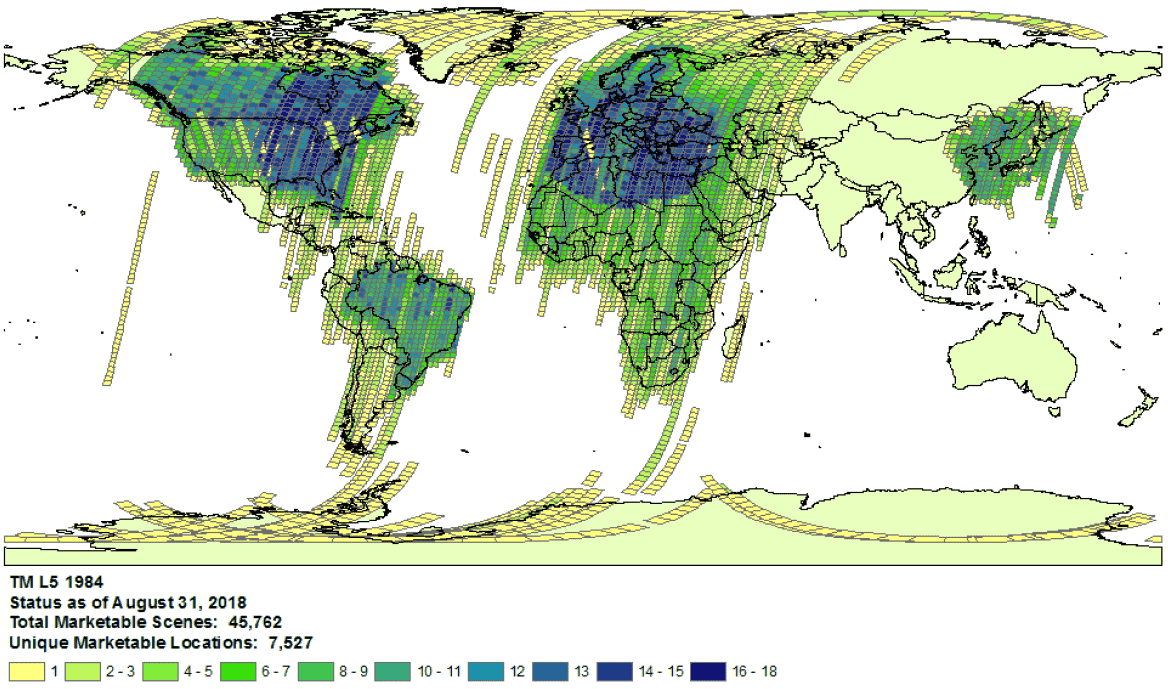الغرض من هذا المستند هو مساعدتك في تحديد ما إذا كانت مادة العرض مفقودة في كتالوج بيانات Earth Engine (المعروف حاليًا باسم Landsat وSentinel وMODIS).
توضّح الخطوات الموضّحة كيفية تنفيذ ما يلي:
ابحث عن مواد العرض المتاحة في كتالوجات Earth Engine ومقدّمي الخدمات.
اجمع المعلومات اللازمة لإرسال تأكيد على عدم توفّر مادة عرض إلى فريق بيانات Earth Engine.
النقاط الشائعة التي يجب أخذها في الاعتبار
مستوى المعالجة: قد لا تكون بعض الصور متاحة لمستوى معالجة أو منتج معيّن. على سبيل المثال، قد لا تتم معالجة الصور المنخفضة الجودة بالمستوى الأعلى.
التغطية المكانية والزمانية: لا يمكن ضمان اتّباع وتيرة منتظمة لكل مجموعة بيانات. يمكن أن يؤثّر الاختلاف في مهام أداة الاستشعار وجودة الصورة وإدارة الأرشيف في مدى توفّر بيانات مقدّم الخدمة.
 مثال على تغطية جمع قياسات Landsat 5 للعام
1984
مثال على تغطية جمع قياسات Landsat 5 للعام
1984
- اختيار مقدّم الخدمة: يتم نقل البيانات إلى "قائمة بيانات Earth Engine" من مقدّم خدمة محدّد لكل مجموعة بيانات. من المحتمَل أنّ مقدّم الخدمة لا يقدّم أرشيفًا كاملاً للمهام. على سبيل المثال، يتم نقل حِزم بيانات Landsat من أرشيف USGS، والذي يُعرف أنّه لا يتضمّن صورًا من محطات استقبال معيّنة لفترات زمنية معيّنة (اطّلِع على جهود LGAC لمزيد من المعلومات).
Landsat
يتم نقل بيانات Landsat من مسح المساحة الجيولوجية في الولايات المتحدة (USGS).
تأكَّد من توفّر تغطية Landsat للوقت والمنطقة المعنيّة.
أجرِ عملية بحث في Earth Engine للحصول على قائمة بجميع مواد العرض للوقت والمنطقة التي تهمّك. احرص على التأكّد من عدم ترشيح أي مواد عرض عن طريق الخطأ في الرمز البرمجي. في ما يلي مثال على نص برمجي. احرص على استيراد المجموعة باستخدام المستوى المناسب من الفئة ومعالجة البيانات (اطّلِع على مزيد من المعلومات حول بنية مجموعة Landsat).
ابحث عن مواد العرض التي يُحتمل أن تكون غير متوفّرة في كتالوج USGS Earth Explorer (اطّلِع على دليل المساعدة للحصول على خطوات تفصيلية حول إجراء عملية بحث واختيار مجموعات البيانات). تأكَّد من مقارنة المنتجات ومستويات المعالجة المناسبة (اطّلِع على بنية مجموعة Landsat). يُرجى العِلم أنّه لا يتم إنشاء منتجات انعكاس سطح الأرض إلا لصور Landsat التي تتضمن مستوى المعالجة L1TP.
شارِك دليلاً مفصّلاً على عدم توفّر مواد العرض من خلال إرسال طلب يتضمن معرّف منتج الموفّر ورابط يؤدي إلى نص برمجي في "محرر الرموز البرمجية في Earth Engine" يؤكّد عدم توفّر مواد العرض.
Sentinel
يتم نقل بيانات Sentinel من موقع Copernicus Dataspace الإلكتروني.
تأكَّد من توفّر تغطية Sentinel للوقت والمنطقة المعنيّة (راجِع تفاصيل المهمة).
ملاحظة: يتم إنشاء منتجات Sentinel-2 Level-2A بشكل منهجي في الجزء الأرضي فوق أوروبا فقط منذ آذار (مارس) 2018، وتم توسيع نطاق الإنتاج ليشمل العالم في كانون الأول (ديسمبر) 2018 (اطّلِع على دليل مستخدم وكالة الفضاء الأوروبية للاطّلاع على مزيد من التفاصيل). وسيتمّ إنشاؤها مجددًا في نهاية المطاف كجزء من المجموعة 1.
أجرِ عملية بحث في Earth Engine للحصول على قائمة بجميع مواد العرض للوقت والمنطقة التي تهمّك. احرص على التأكّد من عدم ترشيح أي مواد عرض عن طريق الخطأ في الرمز البرمجي. في ما يلي مثال على نص برمجي. احرص على استيراد المجموعة بالمستوى الصحيح لمعالجة البيانات.
ابحث عن مواد العرض التي يُحتمل أن تكون غير متوفّرة في كتالوج Copernicus.
شارِك دليلاً مفصّلاً على عدم توفّر مواد العرض من خلال إرسال طلب يتضمن معرّف منتج الموفّر ورابط يؤدي إلى نص برمجي في "محرر الرموز البرمجية في Earth Engine" يؤكّد عدم توفّر مواد العرض.
MODIS
يتم نقل بيانات MODIS من مركز الأرشيف النشط الموزّع لعمليات سطح الأرض (LP DAAC).
أجرِ عملية بحث في Earth Engine للحصول على قائمة بجميع مواد العرض للوقت والمنطقة التي تهمّك. احرص على التأكّد من عدم ترشيح أي مواد عرض عن طريق الخطأ في الرمز البرمجي. في ما يلي مثال على نص برمجي. تأكَّد من استيراد المنتج المقصود.
ابحث عن مواد العرض التي يُحتمل أن تكون غير متوفّرة في مجموعة بيانات USGS والتي لم تتم إضافتها إلى Earth Engine. انتقِل إلى المجلد المناسب وحدِّد أحدث الأدلة المتاحة.
مجموعات البيانات التي تبدأ بـ "MOD" هي من "Terra MODIS"
مجموعات البيانات التي تبدأ بـ "MYD" هي من نوع "Aqua MODIS"
مجموعات البيانات التي تبدأ بـ "MCD" هي في "بيانات MODIS المجمّعة"
مجموعات البيانات التي تبدأ بـ "VNP" هي في "S-NPP VIIRS"
شارِك دليلاً مفصّلاً على عدم توفّر مواد العرض من خلال إرسال طلب يتضمن معرّف منتج الموفّر ورابط يؤدي إلى نص برمجي في "محرر الرموز البرمجية في Earth Engine" يؤكّد عدم توفّر مواد العرض.
